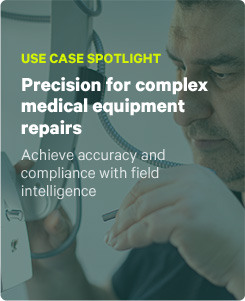As AI continues to revolutionize industries, it’s easy to fall into the trap of viewing it as a shiny new tool that should be implemented everywhere. However, when it comes to field service management, the key to a successful project isn’t about having AI for AI’s sake. Instead, it’s about focusing on specific outcomes and use cases and figuring out where the technology can play a transformational role.
That means using it only where it makes sense in a technician’s workflow so that it enhances the process rather than disrupting it.
Clean data is critical, but it’s not your first step
When thinking about integrating AI into field service, a common first instinct is to concentrate on gathering high-quality data from the field. This is essential because AI thrives on accurate, real-world data to function optimally. It goes without saying that you need clean data, but the intended outcomes dictate what kind of clean data, and in what format, you should be gathering in the field to begin with. This approach allows you to chart your path before your technician even collects their first bit of data.
Instead, the first priority is to identify what your objectives are and use AI where it can make the biggest impact. You should ensure that the workflows where you introduce AI are efficient and optimized on their own, otherwise AI would only compound frustrations. By focusing on a fluid technician experience first, you can then layer in AI and other advanced technologies like IoT when it makes sense to do so, rather than further complicating an already inefficient process.
Enhancing field productivity with AI
AI’s greatest value lies in its ability to enhance technician productivity. However, to make AI truly beneficial in the field, it needs to be approached from the perspective of how it will impact technicians. AI must assist their workflow in a meaningful way, not unnecessarily complicate things with negligible returns. For example, integrating an AI-powered tool like a chatbot can help technicians troubleshoot equipment in real time, but only if it understands their specific context and needs.
To make AI truly work in the field, your platform will have to learn some new tricks.
The first trick: High-quality field data to prompt the AI
AI’s effectiveness is only as good as the data it receives. To prompt AI systems to make helpful recommendations, they must have a rich foundation of field data. This includes not just operational metrics like the type of service or customer problem report, but also real-time observations from technicians themselves. On top of reporting data which often doesn’t include outliers, their insights and direct experiences with the equipment are invaluable to improving AI performance.
Imagine a scenario where AI is assisting a technician with a faulty machine. Without the technician providing real-time context, such as the machine’s unusual sounds or specific error codes, the AI’s recommendations might be off-target. By allowing AI to learn from both back-office system data and technician-provided contextual information, it can make more precise suggestions.
The second trick: Seamless integration into technician workflows
AI needs to be integrated in a way that feels natural to the technician’s workflow. Poorly implemented AI tools can slow them down, which is the opposite of what you’re trying to do. In the field, AI should be viewed in a support capacity – your teams still have KPIs to meet and customers to serve.
Realize that AI recommendations may not always be perfect in the beginning, but allow for continuous improvement through user feedback. It’s not going to be perfect out of the box – but it can only get better with continued use. It’s the interactions between your technicians and your AI services that refine the technology for your specific application. Similarly, the workflows themselves will undergo constant refinement especially as your AI becomes more robust. Therefore, your field platform has to be agile enough that workflow designers can easily make improvements with every iteration.
The third trick: Continuous learning and feedback
You should plan for feedback as a vital tool in this entire AI-enabled process. Make it an integral part of the workflow and design it to be as easy as possible for technicians. Data from the field is the backbone of AI’s learning process. Whether it’s feedback on inaccurate recommendations or new data on an unusual equipment issue, every bit of information helps the AI become smarter.
At TrueContext, our true north is delivering the most fluid and intuitive experience possible for frontline workers because they are the conduit that makes field service possible. Our mobile field workflow platform brings together all of your data, integrated systems, and AI services in one user-friendly package – accessible to your technicians anywhere.
Finding your true north
Finally, always ground your AI project in specific use cases and outcomes. Focus on how AI can help technicians improve their efficiency and safety. Remember, AI is a tool. It should be deployed thoughtfully, in areas where it can provide the most value and allow technicians to do their jobs better. Practicality and an outcome-driven mindset should be the starting point for any AI roadmap.
Transform your organization for AI-ready field service
Book a personalized demo to see how TrueContext can help power fast decisions in the field and keep your system of record up-to-date all the time.




